wheel PONTIAC BONNEVILLE 1993 Owners Manual
[x] Cancel search | Manufacturer: PONTIAC, Model Year: 1993, Model line: BONNEVILLE, Model: PONTIAC BONNEVILLE 1993Pages: 322, PDF Size: 16.31 MB
Page 16 of 322
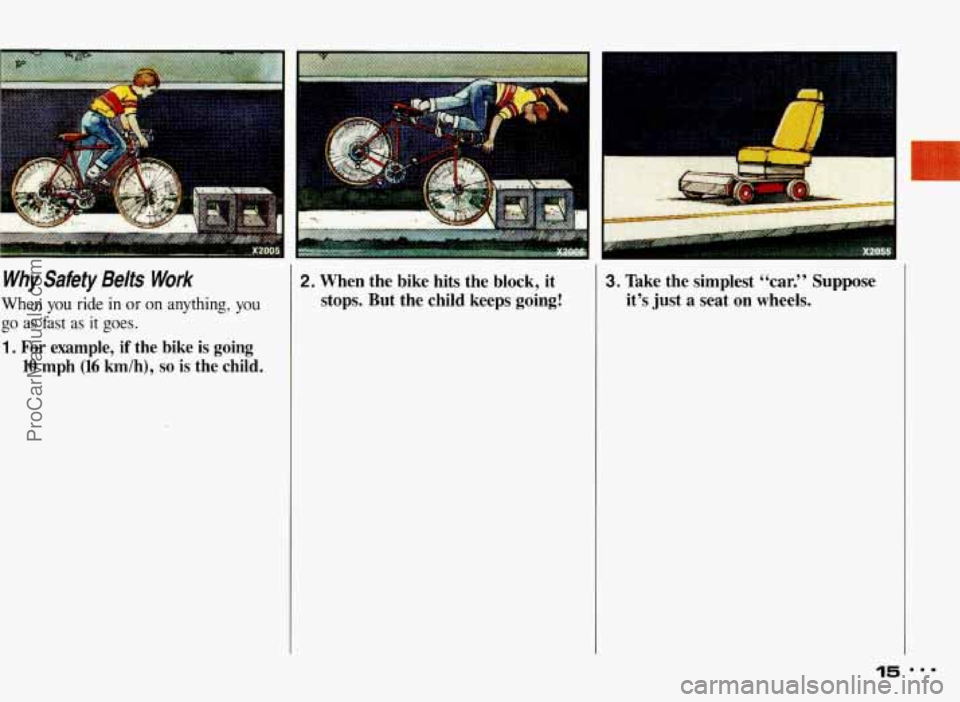
Why Safety Belfs Work
When you ride in or on anything, you
go as fast as it goes.
1. For example, if the bike is going
10 mph (16 kmlh), so is the child.
2. When the bike hits the block, it 3. Take the simplest ‘‘car.’ ’ Suppose
stops. But the child keeps going! it’s
just a seat on wheels.
15
ProCarManuals.com
Page 25 of 322
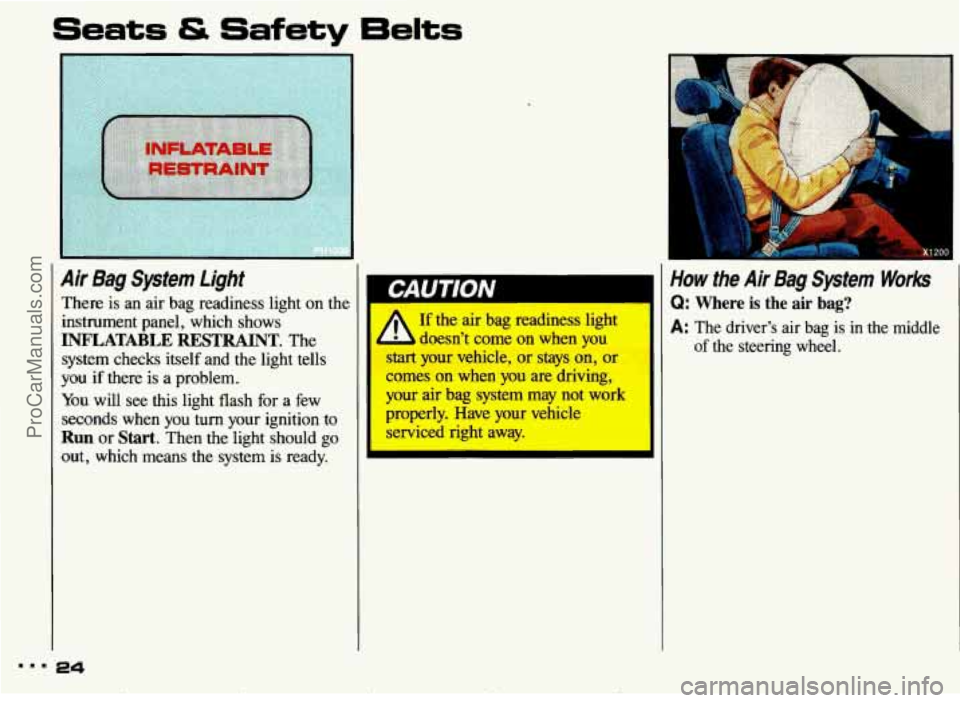
Seats & Safety 6elts
Air Bag System Light
There is an air bag readiness light on the
instrument panel, which shows
INFLATABLE RESTRAINT. The
system checks itself and the light tells
you if there is a problem.
You will see this light flash for a few
seconds when you turn your ignition to
Run or Start. Then the light should go
out, which means the system is ready.
If the air bag readiness light
L b doesn’t come on when you
s t your vehicle, or stays on, or
comes on when you are driving,
your air bag system may
not work
properly. Have your vehicle serviced right away.
4
3
How the Air Bag System Works
Q: Where is the air bag?
A: The driver’s air bag is in the middle
of the steering wheel.
ProCarManuals.com
Page 26 of 322
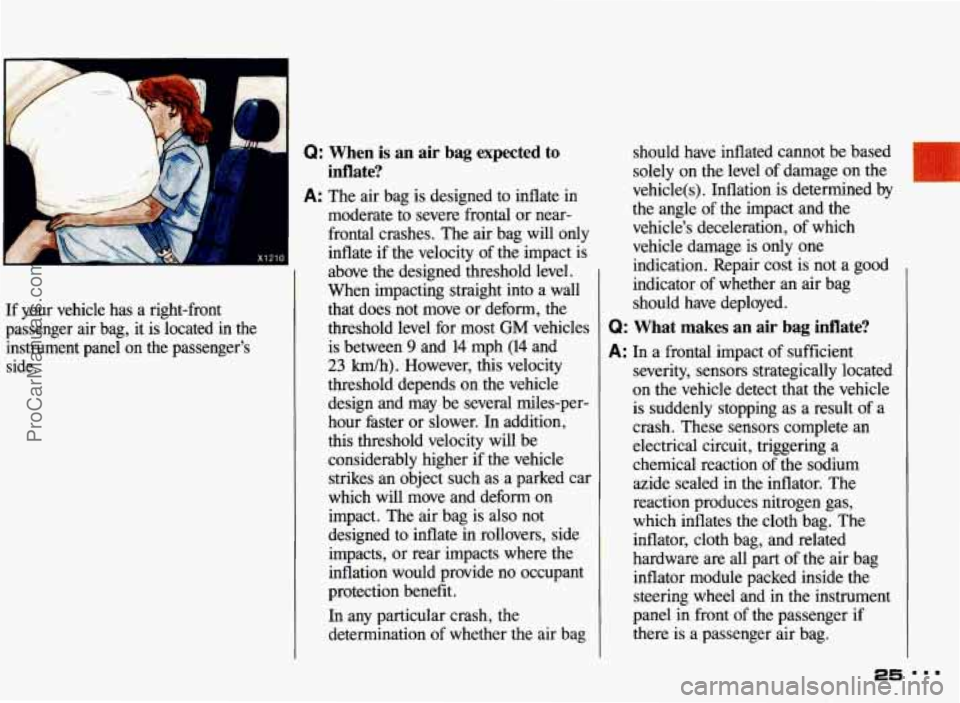
..
A
d Q: When is an air bag expected to
inflate?
A: The air bag is designed to inflate in
x1210 I
If your vehicle has a right-front
passenger air bag, it is located in the instrument panel on the passenger’s
side. moderate to severe
frontal or near-
frontal crashes. The air bag will only
inflate if the velocity
of the impact is
above the designed threshold level.
When impacting straight into a wall
that does not move or deform, the
threshold level for most
GM vehicles
is between
9 and 14 mph (14 and
23 km/h). However, this velocity
threshold depends on the vehicle
design and may be several miles-per-
hour faster or slower. In addition,
this threshold velocity will be
considerably higher
if the vehicle
strikes an object such as a parked car
which will move and deform on
impact. The air bag is also not
designed to inflate
in rollovers, side
impacts, or rear impacts where the
inflation would provide no occupant
protection benefit.
In any particular crash, the
determination of whether the air bag should
have inflated cannot be based
solely
on the level of damage on the
vehicle(s). Inflation is determined by
the angle of the impact and the
vehicle’s deceleration, of which
vehicle damage is
only one
indication. Repair cost is not a good
indicator of whether an air bag
should have deployed.
Q: What makes an air bag inflate?
A: In a frontal impact of sufficient
severity, sensors strategically located
on the vehicle detect that the vehicle
is suddenly stopping as
a result of a
crash. These sensors complete an
electrical circuit, triggering a
chemical reaction of the sodium
azide sealed in the inflator. The
reaction produces nitrogen gas,
which inflates the cloth bag. The
inflator, cloth bag, and related
hardware are all part of the air bag
inflator module packed inside the
steering wheel and in the instrument
panel in front of the passenger if
there is a passenger air bag.
26 DDD
ProCarManuals.com
Page 27 of 322
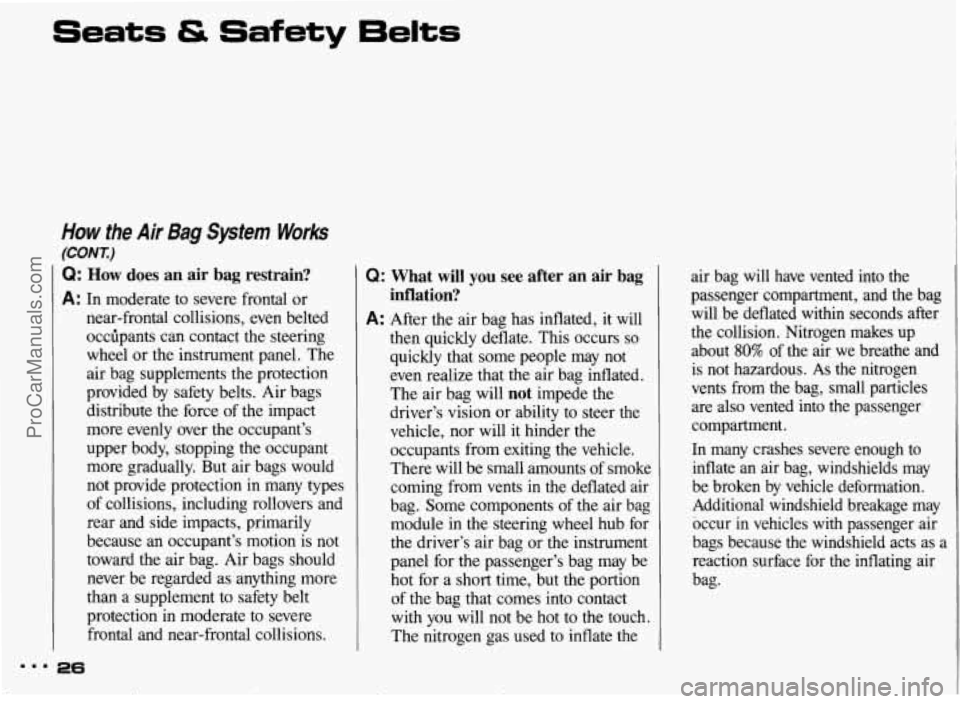
Seats & Safety Belts
How the Air Bag System Works
(CON X)
Q: How does an air bag restrain?
A: In moderate to severe frontal or
near-frontal collisions, even belted
occilpants can contact the steering
wheel or the instrument panel. The
air bag supplements the protection
provided by safety belts. Air bags
distribute the force
of the impact
more evenly over the occupant’s
upper body, stopping the occupant
more gradually. But air bags would
not provide protection
in many types
of collisions, including rollovers and
rear and side impacts, primarily
because an occupant’s motion is not
toward the air bag. Air bags should
never be regarded as anything more
than a supplement
to safety belt
protection in moderate to severe frontal and near-frontal collisions.
Q: What will you see after an air bag
inflation?
A: After the air bag has inflated, it will
then quickly deflate. This occurs
so
quickly that some people may not
even realize that the air bag inflated.
The air bag will
not impede the
driver’s vision or ability to steer the
vehicle, nor will it hinder the
occupants from exiting the vehicle.
There will be small amounts of smoke
coming from vents in the deflated air
bag. Some components of the air bag
module in the steering wheel hub for
the driver’s air bag or the instrument
panel for the passenger’s bag may be
hot for a short time, but the portion
of the bag that comes into contact
with
you will not be hot to the touch.
The nitrogen gas used to inflate the air
bag will have vented into the
passenger compartment, and
the bag
will be deflated within seconds after the collision. Nitrogen makes
up
about 80% of the air we breathe and
is not hazardous.
As the nitrogen
vents from the bag, small particles
are also vented into
the passenger
compartment.
In many crashes severe enough to
inflate an air bag, windshields may
be broken by vehicle deformation.
Additional windshield breakage may
occur in vehicles with passenger air
bags because the windshield acts as a
reaction surface for the inflating air
bag.
mm. 26
L ProCarManuals.com
Page 28 of 322
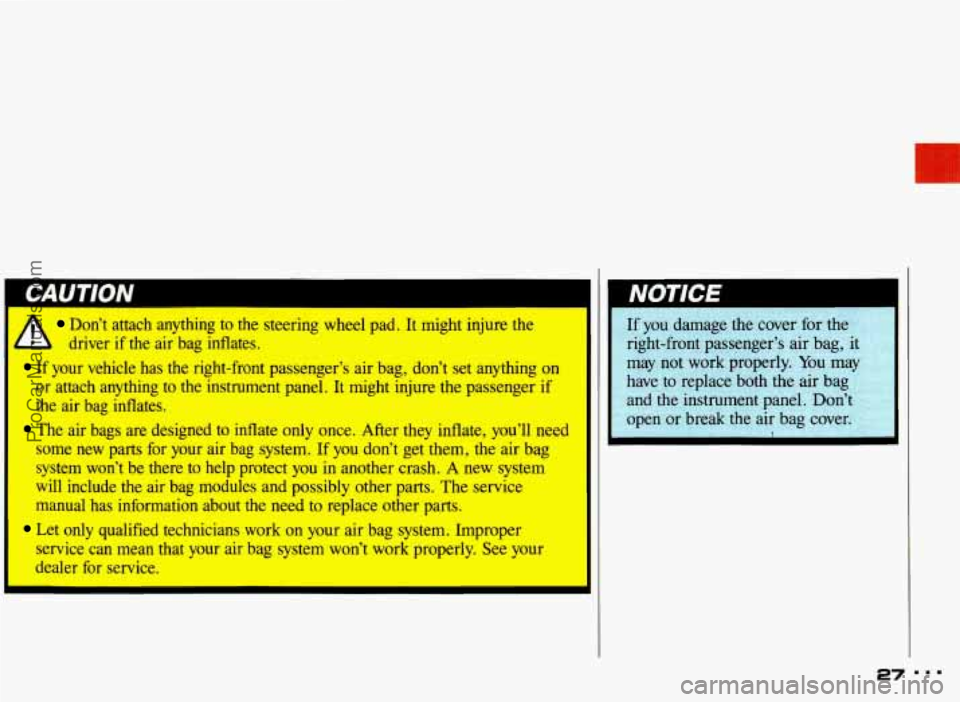
Don’t attach anything to the steering wheel pad. It might injure the
If your vehicle has the right-front passenger’s air bag, don’t set anything on
or attach anything to the instrument panel. It might injure the passenger if
the air bag inflates.
The air bags are designed to inflate only once. After they inflate, you’ll need
some new parts for your air bag system.
If you don’t get them, the air bag
system won’t be there
to help protect you in another crash. A new system
will include the air bag modules and possibly other parts. The service
manual has information about the need to replace other parts.
Let only qualified technicians work on your air bag system. Improper
service can mean that your air bag system won’t work properly.
See your
dealer
for service.
b driver if the air bag inflates.
If you damage the cover for the
right-front passenger’s air bag, it
may not work properly.
You may
have to replace both the air bag
and the instrument panel. Don’t
open or break the air bag cover.
7
27
ProCarManuals.com
Page 52 of 322
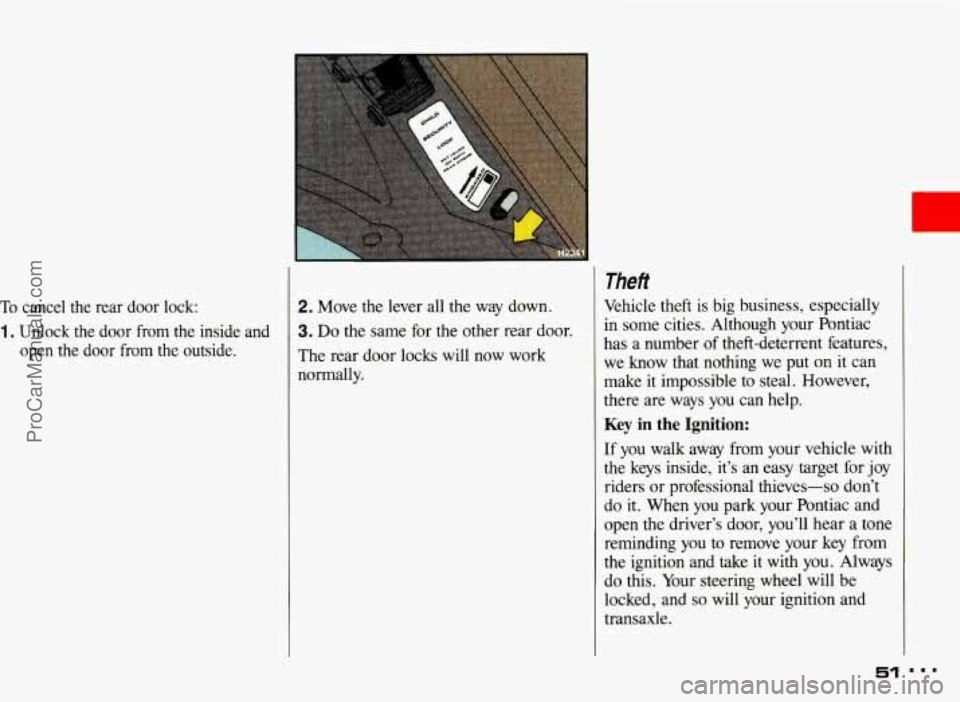
To cancel the rear door lock:
1. Unlock the door from the inside and
open the door from the outside.
2. Move the lever all the way down.
3. Do the same for the other rear door.
The rear door locks will now work
normally.
Theft
Vehicle theft is big business, especially
in some cities. Although your Pontiac
has a number
of theft-deterrent features,
we know that nothing we put
on it can
make it impossible to steal. However,
there are ways you can help.
Key in the Ignition:
If you walk away from your vehicle with
the keys inside, it’s an easy target for joy
riders or professional thieves-so don’t
do
it. When you park your Pontiac and
open the driver’s door, you’ll hear a tone
reminding you
to remove your key from
the ignition and take it with you. Always
do this. Your steering wheel will be
locked, and
so will your ignition and
transaxle.
51
ProCarManuals.com
Page 58 of 322
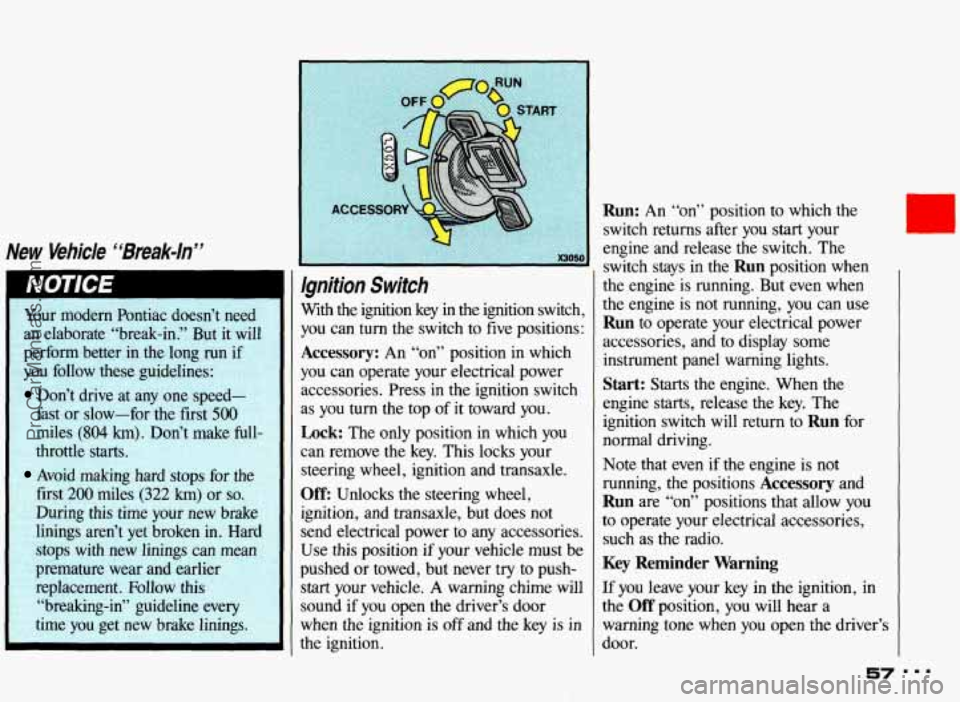
New Venice bbBreak-ln”
Your modern Pontiac doesn’t need
an elaborate “break-in.” But it will
perform better
in the long run if
you follow these guidelines:
Don’t drive at any one speed-
fast or slow-for the first
500
.miles (804 km). Don’t make full-
throttle
starts.
Avoid making hard stops for the
first 200 miles (322 km) or so.
During this time your new brake
linings aren’t yet broken in. Hard
stops
with new linings can mean
premature wear and earlier
replacement. Follow this “breaking-in” guideline every
time you get
new brake linings.
Ignition Switch
With the ignition key in the ignition switch,
you can turn the switch to five positions:
Accessory: An “on” position in which
you can operate your electrical power
accessories. Press in the ignition switch
as
you turn the top of it toward you.
Lock: The only position in which you
can remove the key. This locks your
steering wheel, ignition and transaxle.
Off: Unlocks the steering wheel,
ignition, and transaxle, but does not
send electrical power to any accessories.
Use this position if your vehicle must be
pushed or towed, but never try to push-
start your vehicle. A warning chime will
sound if you open the driver’s door
when the ignition is
off and the key is in
the ignition.
Run: An “on” position to which the
switch returns after you
start your
engine and release the switch. The
switch stays in the
Run position when
the engine is running. But even when
the engine is not running, you can use
Run to operate your electrical power
accessories, and to display some
instrument panel warning lights.
Start: Starts the engine. When the
engine starts, release the key. The
ignition switch will return to
Run for
normal driving.
Note that even if the engine
is not
running, the positions
Accessory and
Run are “on” positions that allow you
to operate your electrical accessories,
such as the radio.
Key Reminder Warning
If you leave your key in the ignition, in
the
Off position, you will hear a
warning tone when you open the driver’s
door.
57 ===
ProCarManuals.com
Page 63 of 322
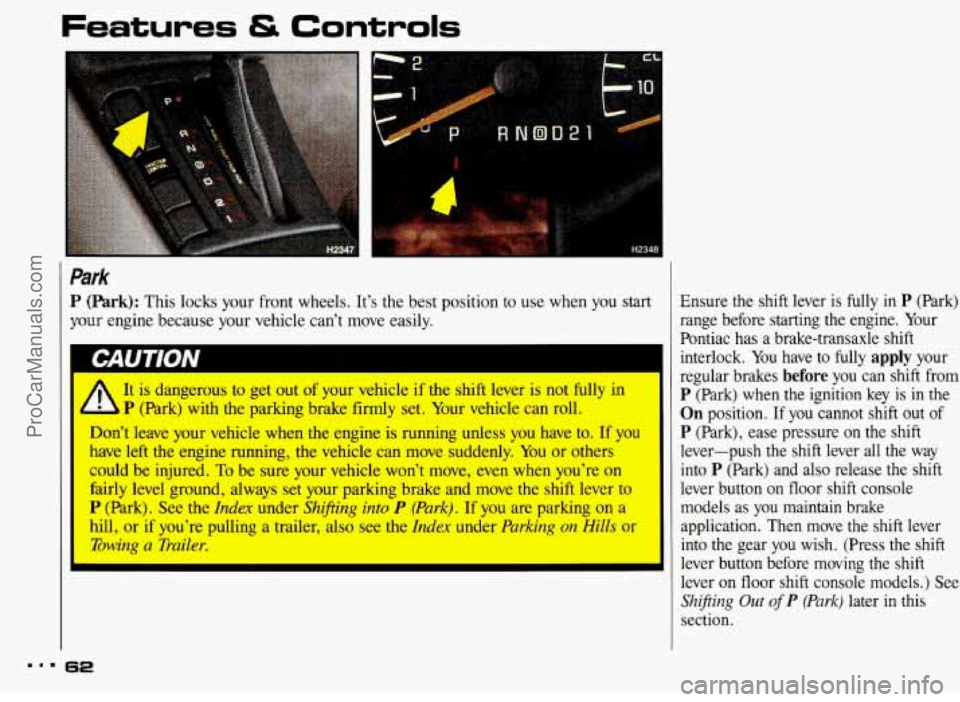
5 & Controls
Park
P (Park): This locks your front wheels. It’s the best position to use when you start
your engine because your vehicle can’t move easily.
1 It is dangerous to get out of your vehicle if the shift lever is not my in
Don’t leave your vehicle when the engine is running unless you have to. If you
have left the engine running, the vehicle can move suddenly. You or others
could be injured. To be sure your vehicIe won’t move, even when you’re on
fkirly level ground, always set your parking brake and move the shift lever to
P (Fark). See the Inda under Shiping into P (Park). If you are parking on a
hill, or if you’re pulling a trailer, also see the Inda under Parking on HilZs or
Towing a llailer.
- P (park) with the parking brake firmly set. Your vehicle can roll.
Ensure the shift lever is fully in P (Park)
range before starting the engine. Your
Pontiac has a brake-transaxle shift
interlock. You have to fully
apply your
regular brakes
before you can shift from
P (Park) when the ignition key is in the
On position. If you cannot shift out of
P (Park), ease pressure on the shift
lever-push the shift lever all the way into
P (Park) and also release the shift
lever button
on floor shift console
models as you maintain brake
application. Then move the shift lever
into the gear you wish. (Press the shift
lever button before moving the shift
lever on floor shift console models.) See
Shifting Out of P (Park} later in this
section.
I.. 62
ProCarManuals.com
Page 64 of 322
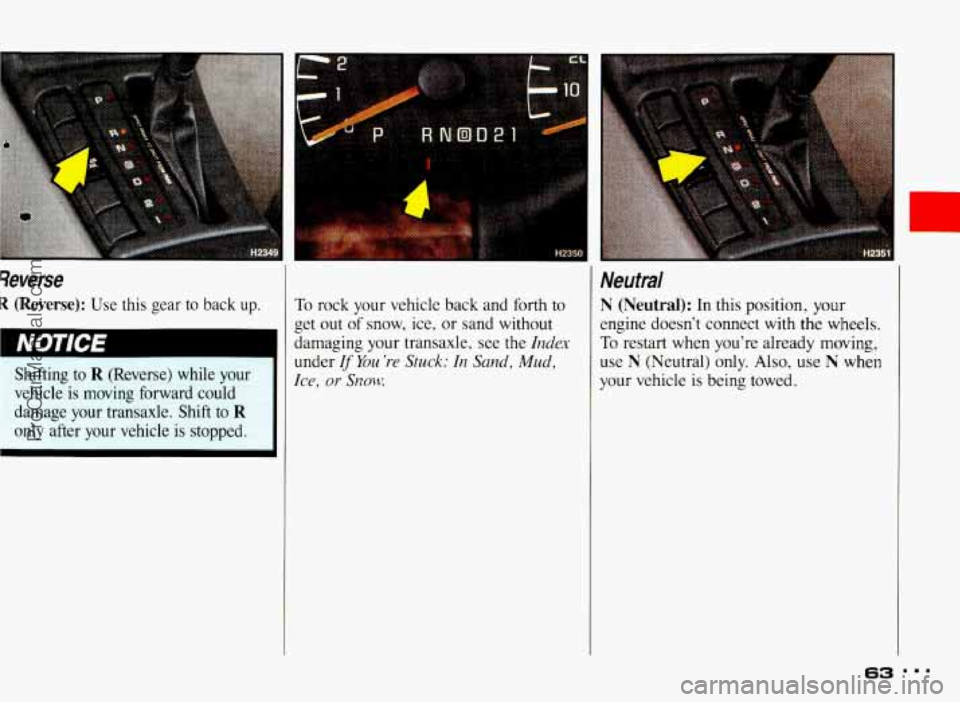
Severse
R (Reverse): Use this gear to back up.
Shifting to
R (Reverse) while your
vehicle
is moving forward could
damage your transaxle. Shift to
R
only after your vehicle is stopped.
To rock your vehicle back and forth to
get out
of snow, ice, or sand without
damaging your transaxle, see the
Index
under If You ’re Stuck: In Sand, Mud,
Ice, or Sy10w.
r
Neutral
N (Neutral): In this position, your
engine doesn’t connect
with the wheels.
To restart when you’re already moving,
use
N (Neutral) only. Also, use N when
your vehicle is being towed.
63 ..I
ProCarManuals.com
Page 67 of 322
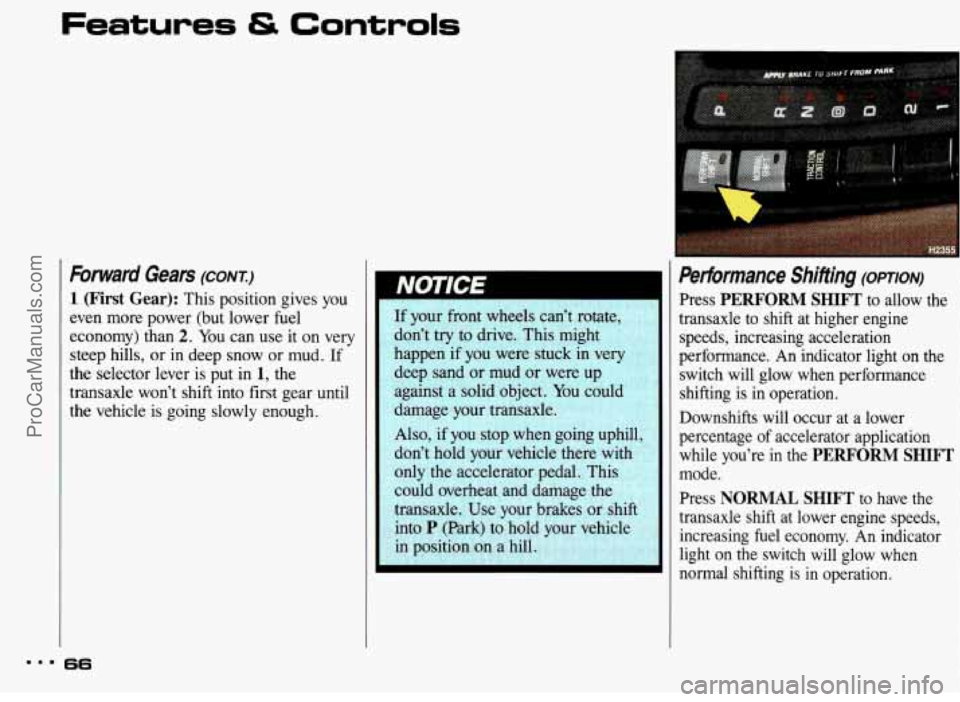
Features & Controls
Forward Gears (CONT.)
1 (First Gear): This position gives you
even more power (but lower fuel
economy) than
2. You can use it on very
steep hills, or in deep snow or
mud. If
the selector lever is put in
1, the
transaxle won’t shift into first gear until
the vehicle is going slowly enough.
66
If your front wheels can’t rotate,
don’t try to drive. This might
happen if you were stuck
in very
deep sand or mud or were up
against a solid object. You could
damage your transaxle.
Also,
if you stop when going uphill,
don’t hold your vehicle there with
only the accelerator pedal. This
could overheat and damage the
transaxle.
Use your brakes or shift
into
P (Park) to hold your vehicle
in position
on a hill.
Performance Shifting (opTIoN)
Press PERFORM SHIFT to allow the
transaxle to shift at higher engine
speeds, increasing acceleration
performance. An indicator light on the
switch will glow when performance
shifting is in operation.
Downshifts will occur at a lower
percentage
of accelerator application
while you’re in the
PERFORM SHIFT
mode.
Press
NORMAL SHIFT to have the
transaxle shift at lower engine speeds, increasing fuel economy. An indicator
light on the switch will glow when
normal shifting is in operation.
ProCarManuals.com